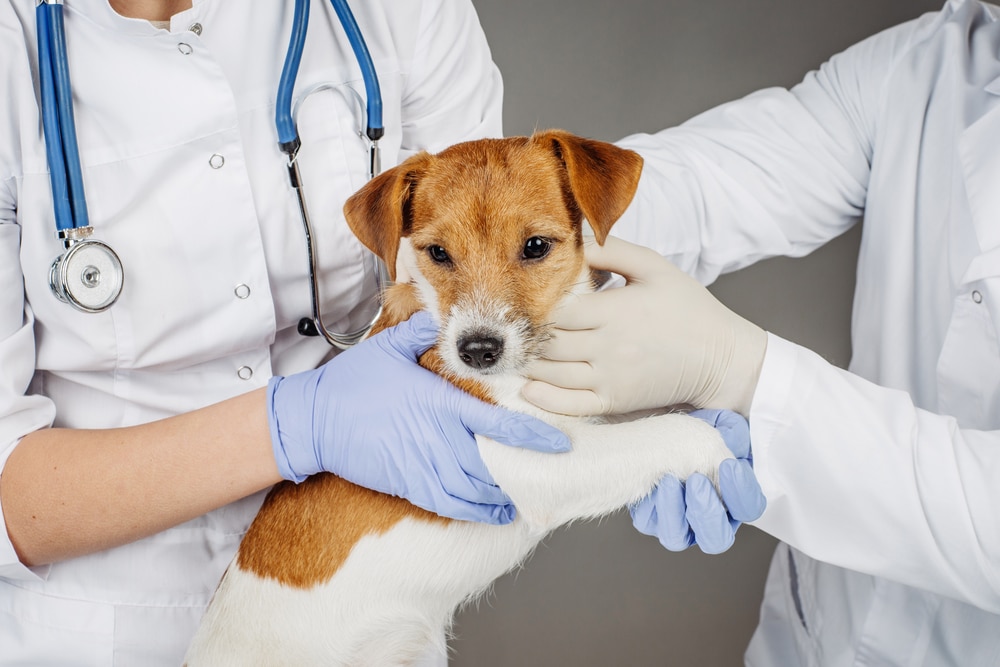Musculoskeletal disorders in dogs can occur at any age. Just like us, dogs are susceptible to minor strains and sprains, which usually resolve with rest. Sometimes a problem is more serious, so seek veterinary help if your dog persistently limps or is unwilling to exercise.
Signs of a Problem
- Limping (head lifted as lame forelimb lands on ground)
- Stiffness after resting
- Unwillingness to exercise; hanging back while on walk
- Reluctance to climb stairs or to jump into car
- Pain, swelling, and heat in joint
- Ataxia (loss of coordination) and paralysis
- Sudden halt during activity (and perhaps holding up back paw)
Arthritis
If a joint is unstable due to an injury or to a skeletal abnormality such as hip dysplasia, arthritis may develop as a dog ages. This disease is associated with damage and inflammation that restrict joint movement and cause pain. Normal wear and tear can also lead to arthritis, especially if a dog has led a very active life or is overweight.
To investigate and diagnose an arthritic joint, your vet will palpate and manipulate the area, looking for swelling, heat, and abnormal movement, and may want to watch your dog move as you walk him.
Further investigation may be needed, such as X-rays or withdrawal of a small sample of fluid from the joint for testing. MRI scanning is also increasingly used.
As w ell as pain relief with non-steroidal anti-inflammatory drugs, other ways of managing arthritis include weight control, changing your dog’s exercise regime (taking him for more frequent but shorter walks), acupuncture, non-weight-bearing exercise such as swimming (hydrotherapy), and physiotherapy.
ell as pain relief with non-steroidal anti-inflammatory drugs, other ways of managing arthritis include weight control, changing your dog’s exercise regime (taking him for more frequent but shorter walks), acupuncture, non-weight-bearing exercise such as swimming (hydrotherapy), and physiotherapy.
Glucosamine, chondroitin, hyaluronic acid, and omega-3 fatty acids may also help, either taken as dietary supplements or included within the formulation of certain foods.
Panosteitis
In young, still-developing dogs, a bone disease called panosteitis can affect bone growth, causing lameness in different limbs at different times. This condition is especially common in larger breeds such as German Shepherds and Great Danes.
Panosteitis is confirmed by X-ray and treated with rest and pain relief. The problem is usually temporary.
Prolapsed Disc
A dog who is suddenly reluctant to go up stairs or jump into the car may have temporary neck or back pain, which improves with rest and anti-inflammatory drugs. A more serious problem, seen especially in long-backed breeds such as Bassett Hounds and Dachshunds, is prolapse of one or more intervertebral discs.
Symptoms may include pain, weakness, or paralysis of the hindlimbs—and the forelimbs if the prolapse is in the neck—and loss of sensation below the area of the affected disc.
Strict rest and pain relief may be enough for recovery, but surgery, after X-ray and MRI to pinpoint the problem, may be needed. If bladder and bowel control are lost, the outlook is poor.
Hind Leg Disorders
It is common to see a dog, particularly a small breed such as a West Highland White or Yorkshire Terrier, trotting along and then skipping while carrying one back leg off the ground for a few steps before walking on all four paws again.
He probably has an intermittently slipping kneecap (luxating patella), commonly caused by the groove housing the kneecap being too shallow. The problem can be corrected surgically, but this is usually only necessary in a big dog, since little dogs cope very well.
Another common hind leg problem is rupture of the cranial cruciate ligament, one of the stabilizing ligaments within the knee joint. This is often associated with an active dog who dashes off after a ball only to stop suddenly, holding up a back paw.
Golden Retrievers and German Shepherds are among the breeds that seem to be prone. Surgery offers the best chance of recovery. For small dogs, pain relief and strict rest for several weeks may work.
Avoiding Overload
Keeping your dog’s weight at the correct level for his size and breed is one of the most important things you can do to help prevent joint problems.
Obesity is not only detrimental to your dog’s general health, it also overloads his joints, increasing the risk of irreversible and painful disorders such as arthritis.

